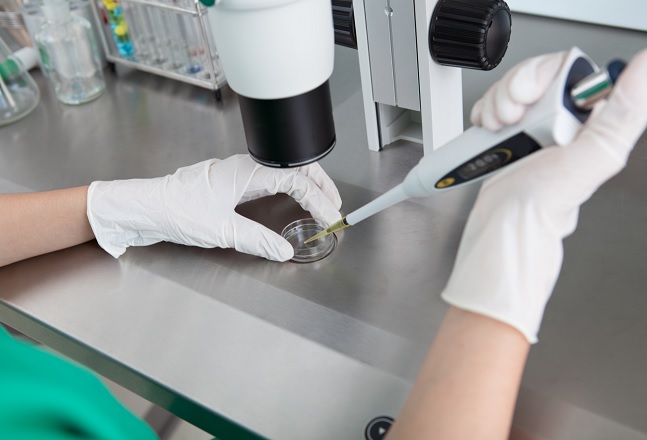Thousands of American women have
fertility treatments including IVF every year, and it has been proven to be safe over time. However, in very rare cases, there may be complications which can be serious.

The American Society for Reproductive Medicine (ASRM) identifies risks in these six areas:• Medications
• Egg retrieval
• Embryo transfer
• Multiple pregnancy
• Birth defects
• Miscarriage and ectopic pregnancyIt’s important to remember that these complications are rare, and that your fertility specialist will monitor you closely and use all her or his experience and expertise to prevent any of them from happening to you.
Medication Side Effects
The drugs used for ovarian stimulation have mild side effects for some women, including mild bruising and soreness at the injection site, headaches, an upset stomach, and mood swings. Another side effect is ovarian hyperstimulation syndrome (OHSS.) This happens when the ovaries produce many follicles and fluid may leak from the blood vessels into the abdominal cavity and lungs.Usually this is mild and resolves on its own without treatment. In severe cases OHSS can result in very enlarged ovaries, dehydration, and large amounts of fluid in the lungs and abdomen. In less than one percent of women undergoing egg retrieval through IVF, OHSS can lead to blood clots and kidney failure, according to ASRM. This is one of the reasons that patients who are taking gonadotropins go for frequent monitoring, to make sure this is not starting to happen. Fertility doctors can moderate the amount of drugs being prescribed or alter the medication regimen if they see any indication of potential trouble.
Egg Retrieval
Once the eggs are ripened the female patient comes to the fertility center for egg retrieval, usually 10 to 14 days after the cycle begins. Usually she is sedated (either with a combination of drugs that allow her to relax and feel no pain while remaining conscious, called conscious sedation, or she is completely “put under” and unconscious, called full sedation) while the reproductive endocrinologist inserts a thin needle into the ovary to extract the eggs, using vaginal ultrasound to guide the needle placement. It’s possible to feel mild to moderate discomfort during or after this procedure, very much like the “pinch” you feel with a pap smear.In rare cases, there may be excessive bleeding from the ovaries or injuries to organs close to the ovaries, such as the bladder, bowel or blood vessels. If the injury is severe, blood transfusions or surgery to repair the damage may be needed. Another risk is pelvic infection. Again, this is very rare, but women who have had prior pelvic infections are at more risk of this complication.
During Embryo Transfer
When the embryos are transferred a speculum (that metal thing your gynecologist uses during a pelvic exam) is placed in the vagina and the embryos are placed into the uterus using a catheter. Some women experience mild cramping when the catheter is inserted through the cervix.
Multiple Pregnancy
Your doctor will discuss with you the chance of having twins or more and you will decide together how many embryos to transfer. Obviously, if you only transfer one embryo the risk of having more than one baby is greatly reduced, giving a better chance of a healthy baby and a less complicated pregnancy for the mom. However, elective single embryo transfer (eSET) is not indicated in all IVF cases and may reduce your chances of getting pregnant significantly if you are not a good candidate for it. The number of embryos to transfer depends on the female patient’s age and other factors. ASRM, the American Society for Reproductive Medicine has guidelines which are recommended to reduce the chance of a multiple pregnancy. ASRM recommends:• For patients under age 35 who have a more favorable prognosis, consideration should be given to transferring only one embryo. No more than two should be transferred.
• For patients between 35 and 37 years of age who have a more favorable prognosis, no more than two cleavage-stage (2 or 3 days after fertilization) embryos should be transferred. All others in this age group should have no more than three transferred. If extended culture is performed (a 5- or 6-day embryo, called a blastocyst) no more than two should be transferred.
• For patients between 38 and 40 years of age with a more favorable prognosis, no more than three embryos or two blastocysts should be transferred. All others in this age group should have no more than four embryos or three blastocysts transferred.
• For patients 41 to 42 years old, no more than five embryos or three blastocysts should be transferred.What is a “more favorable prognosis”? ASRM defines this as 1) first cycle of IVF; 2) good-quality embryos as judged by morphologic criteria; and 3) excess embryos of sufficient quality to warrant cryopreservation (freezing.) Patients who have had previous success with IVF also are regarded as being in a more favorable prognostic category.The risks of a multiple pregnancy affect the mother and the babies, including early labor and delivery (which are risky for the infant), Cesarean delivery, maternal high blood pressure, and gestational diabetes. If you do have a high-multiple pregnancy, defined as three or more fetuses, it is strongly suggested that you consult a physician who specializes in high-risk pregnancies, or you may want to consider reducing the number of embryos you are carrying. Both possibilities should be discussed with the doctor and your partner if you have one.
Birth Defects
The risk of birth defects in IVF babies is only slightly increased over that for naturally conceived babies. Babies conceived naturally have a 2 to 3 percent chance of having birth defects, while IVF-conceived babies have a risk estimated at 2.6 to 3.9 percent. Intracytoplasmic sperm injection (ICSI), which may be used as part of the IVF procedure, may increase the risk of sex chromosome abnormalities, according to ASRM.
Miscarriage and Ectopic Pregnancy
The rate of miscarriage after IVF is similar to that of natural conception, about 12-15% for women in their 20’s. Risk increases with the age of the mother in either case, and may be as high as more than 50 percent for women in their 40’s. Ectopic pregnancy, when the embryo implants in the fallopian tube instead of the uterus, is rare with IVF. This is a potentially dangerous medical emergency and must be treated quickly to end the pregnancy and prevent serious health problems or even death. If you are pregnant and you feel a sharp, stabbing pain; vaginal spotting or bleeding; dizziness; fainting; low back pain; or low blood pressure, call your doctor immediately.
The Risks Are Low, and the Reward is a Baby
The chance that anything serious will happen to you or your baby is very small. IVF helps thousands of people have families every year here in the U.S.
 The American Society for Reproductive Medicine (ASRM) identifies risks in these six areas:• Medications
• Egg retrieval
• Embryo transfer
• Multiple pregnancy
• Birth defects
• Miscarriage and ectopic pregnancyIt’s important to remember that these complications are rare, and that your fertility specialist will monitor you closely and use all her or his experience and expertise to prevent any of them from happening to you.
The American Society for Reproductive Medicine (ASRM) identifies risks in these six areas:• Medications
• Egg retrieval
• Embryo transfer
• Multiple pregnancy
• Birth defects
• Miscarriage and ectopic pregnancyIt’s important to remember that these complications are rare, and that your fertility specialist will monitor you closely and use all her or his experience and expertise to prevent any of them from happening to you. The American Society for Reproductive Medicine (ASRM) identifies risks in these six areas:• Medications
• Egg retrieval
• Embryo transfer
• Multiple pregnancy
• Birth defects
• Miscarriage and ectopic pregnancyIt’s important to remember that these complications are rare, and that your fertility specialist will monitor you closely and use all her or his experience and expertise to prevent any of them from happening to you.
The American Society for Reproductive Medicine (ASRM) identifies risks in these six areas:• Medications
• Egg retrieval
• Embryo transfer
• Multiple pregnancy
• Birth defects
• Miscarriage and ectopic pregnancyIt’s important to remember that these complications are rare, and that your fertility specialist will monitor you closely and use all her or his experience and expertise to prevent any of them from happening to you. The American Society for Reproductive Medicine (ASRM) identifies risks in these six areas:• Medications
• Egg retrieval
• Embryo transfer
• Multiple pregnancy
• Birth defects
• Miscarriage and ectopic pregnancyIt’s important to remember that these complications are rare, and that your fertility specialist will monitor you closely and use all her or his experience and expertise to prevent any of them from happening to you.
The American Society for Reproductive Medicine (ASRM) identifies risks in these six areas:• Medications
• Egg retrieval
• Embryo transfer
• Multiple pregnancy
• Birth defects
• Miscarriage and ectopic pregnancyIt’s important to remember that these complications are rare, and that your fertility specialist will monitor you closely and use all her or his experience and expertise to prevent any of them from happening to you.


